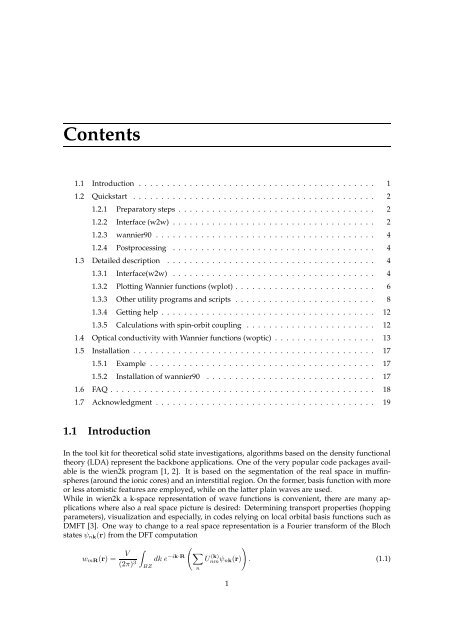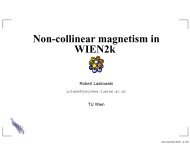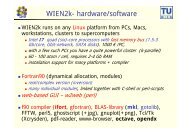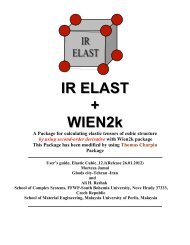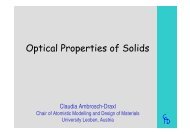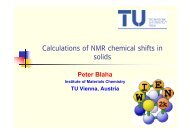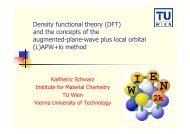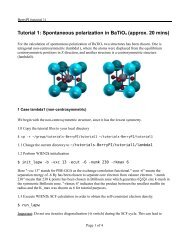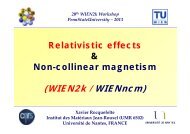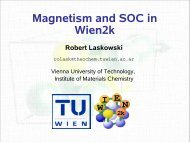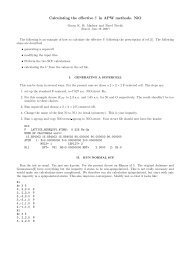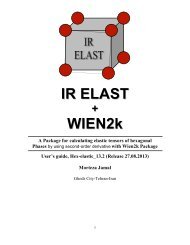userguide WIEN2WANNIER: From linearized augmented ... - WIEN 2k
userguide WIEN2WANNIER: From linearized augmented ... - WIEN 2k
userguide WIEN2WANNIER: From linearized augmented ... - WIEN 2k
You also want an ePaper? Increase the reach of your titles
YUMPU automatically turns print PDFs into web optimized ePapers that Google loves.
Contents1.1 Introduction . . . . . . . . . . . . . . . . . . . . . . . . . . . . . . . . . . . . . . . . . . 11.2 Quickstart . . . . . . . . . . . . . . . . . . . . . . . . . . . . . . . . . . . . . . . . . . . 21.2.1 Preparatory steps . . . . . . . . . . . . . . . . . . . . . . . . . . . . . . . . . . . 21.2.2 Interface (w2w) . . . . . . . . . . . . . . . . . . . . . . . . . . . . . . . . . . . . 21.2.3 wannier90 . . . . . . . . . . . . . . . . . . . . . . . . . . . . . . . . . . . . . . . 41.2.4 Postprocessing . . . . . . . . . . . . . . . . . . . . . . . . . . . . . . . . . . . . 41.3 Detailed description . . . . . . . . . . . . . . . . . . . . . . . . . . . . . . . . . . . . . 41.3.1 Interface(w2w) . . . . . . . . . . . . . . . . . . . . . . . . . . . . . . . . . . . . 41.3.2 Plotting Wannier functions (wplot) . . . . . . . . . . . . . . . . . . . . . . . . . 61.3.3 Other utility programs and scripts . . . . . . . . . . . . . . . . . . . . . . . . . 81.3.4 Getting help . . . . . . . . . . . . . . . . . . . . . . . . . . . . . . . . . . . . . . 121.3.5 Calculations with spin-orbit coupling . . . . . . . . . . . . . . . . . . . . . . . 121.4 Optical conductivity with Wannier functions (woptic) . . . . . . . . . . . . . . . . . . 131.5 Installation . . . . . . . . . . . . . . . . . . . . . . . . . . . . . . . . . . . . . . . . . . . 171.5.1 Example . . . . . . . . . . . . . . . . . . . . . . . . . . . . . . . . . . . . . . . . 171.5.2 Installation of wannier90 . . . . . . . . . . . . . . . . . . . . . . . . . . . . . . 171.6 FAQ . . . . . . . . . . . . . . . . . . . . . . . . . . . . . . . . . . . . . . . . . . . . . . . 181.7 Acknowledgment . . . . . . . . . . . . . . . . . . . . . . . . . . . . . . . . . . . . . . . 191.1 IntroductionIn the tool kit for theoretical solid state investigations, algorithms based on the density functionaltheory (LDA) represent the backbone applications. One of the very popular code packages availableis the wien<strong>2k</strong> program [1, 2]. It is based on the segmentation of the real space in muffinspheres(around the ionic cores) and an interstitial region. On the former, basis function with moreor less atomistic features are employed, while on the latter plain waves are used.While in wien<strong>2k</strong> a k-space representation of wave functions is convenient, there are many applicationswhere also a real space picture is desired: Determining transport properties (hoppingparameters), visualization and especially, in codes relying on local orbital basis functions such asDMFT [3]. One way to change to a real space representation is a Fourier transform of the Blochstatesψ nk (r) from the DFT computation(w mR (r) = V ∑(2π)∫BZ3 dk e −ik·R nU (k)nm ψ nk(r)). (1.1)1


